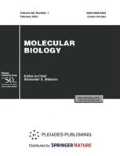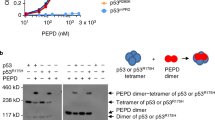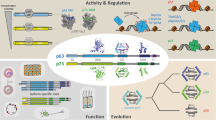Abstract
The nuclear oncoprotein prothymosin α (ProTα) was tested for the ability to regulate the p53 activity with the use of a reporter gene controlled by a p53-responsive promoter. Overexpression of the ProTα gene stimulated the p53 activity, while downregulation of the endogenous ProTα level via RNA interference suppressed transcription of the reporter gene. An increase in ProTα activated p53-dependent transcription and increased the intracellular p53 content in human HeLa, but not HCT116, cells. N-terminal deletions had almost no effect on the ability of ProTα to activate p53-dependent transcription, while deletions from the central region and C-terminal mutations distorting the active transport of ProTα into the cell nucleus prevented its transactivating effect. Mutations affecting Keap1 binding did not impair the ProTα ability to activate the p53-responsive reporter gene. Based on the results, stimulation of p53-dependent transcription was ascribed to the central acidic region of ProTα. The conclusion was supported by the fact that parathymosin, another protein containing an extended acidic region, was also capable of activating p53.
Similar content being viewed by others
References
Pineiro A., Cordero O., Nogueira M. 2000. Fifteen years of prothymosin α: Contradictory past and new horizons. Peptides. 21, 1433.
Vartapetian A.B., Uversky V.N. 2003. Prothymosin α: A simple yet mysterious protein. In: Protein Structures: Kaleidoscope of Structural Properties and Functions. Trivandrum, India: Research Signpost.
Letsas K.P., Frangou-Lazaridis M. 2006. Surfing on prothymosin α proliferation and anti-apoptotic properties. Neoplasma. 53, 92–96, 92–96.
Orre R.S., Cotter M.A., Subramanian C., Robertson E.S. 2000. Prothymosin α functions as a cellular oncoprotein by inducing transformation of rodent fibroblasts in vitro. in vitro. J. Biol. Chem. 17, 1794–1799.
Evstafieva A.G., Belov G.A., Kalkum M., Chichkova N.V., Bogdanov A.A., Agol V.I., Vartapetian A.B. 2000. Prothymosin α fragmentation in apoptosis. FEBS Lett. 467, 150–154.
Evstafieva A.G., Belov G.A., Rubtsov Y.P., Kalkum M., Joseph B., Chichkova N.V., Sukhacheva E.A., Bogdanov A.A., Pettersson R.F., Agol V.I., Vartapetian A.B. 2003. Apoptosis-related fragmentation, translocation, and properties of human prothymosin α. Exp. Cell Res. 284, 211–223.
Jiang X., Kim H.E., Shu H., Zhao Y., Zhang H., Kofron J., Donnelly J., Burns D., Ng S.C., Rosenberg S., Wang X. 2003. Distinctive roles of PHAP proteins and prothymosin-α in a death regulatory pathway. Science. 299, 223–226.
Karetsou Z., Kretsovali A., Murphy C., Tsolas O., Papamarcaki T. 2002. Prothymosin α interacts with the CREB-binding protein and potentiates transcription. EMBO Rep. 3, 361–366.
Subramanian C., Hasan S., Rowe M., Hottiger M., Orre R., Robertson E.S. 2002. Epstein-Barr virus nuclear antigen 3C and prothymosin α interact with the p300 transcriptional coactivator at the CH1 and CH3/HAT domains and cooperate in regulation of transcription and histone acetylation. J. Virol. 76, 4699–4708.
Karapetian R.N., Evstafieva A.G., Abaeva I.S., Chichkova N.V., Filonov G.S., Rubtsov Y.P., Sukhacheva E.A., Melnikov S.V., Schneider U, Wanker E.E., Vartapetian A.B. 2005. Nuclear oncoprotein prothymosin α is a partner of Keap1: Implications for expression of oxidative stress-protecting genes. Mol. Cell Biol. 25, 1089–1099.
Harris S.L., Levine A.J. 2005. The p53 pathway: Positive and negative feedback loops. Oncogene. 24, 2899–2908.
Chumakov P.M. 2000. Function of p53 gene: A life-ordeath choice. Biokhimiya. 65, 34–47.
Inoue T., Wu L., Stuart J., Maki C.G. 2005. Control of p53 nuclear accumulation in stressed cells. FEBS Lett. 579, 4978–4984.
Scheffner M., Huibregtse J.M., Vierstra R.D., Howley P.M. 1993. The HPV-16 E6 and E6-AP complex functions as a ubiquitin-protein ligase in the ubiquitination of p53. Cell. 75, 495–505.
Guryanova O.A., Makhanov M., Chenchik A.A., Chumakov P.M. 2006. Optimization of a genome-wide disordered lentivector-based short hairpin RNA library. Mol. Biol. 40, 448–459.
Shakulov V.R., Vorobjov I.A., Rubtsov Yu.P., Chichkova N.V., Vartapetian A.B. 2000. Interaction of yeast importin with the NLS of prothymosin α is insufficient to trigger nuclear uptake of cargoes. Biochim. Biophys. Res. Commun. 274, 548–552.
Sukhacheva E.A., Evstafieva A.G., Fateeva T.V., Shakulov V.R., Efimova N.A., Karapetian R.N., Rubtsov Y.P., Vartapetian A.B. 2002. Sensing prothymosin α origin, mutations and conformation with monoclonal antibodies. J. Immunol. Meth. 266, 185–196.
Evstafieva A.G., Chichkova N.V., Makarova T.N., Vartapetian A.B., Vasilenko A.V., Abramov V.M., Bogdanov A.A. 1995. Overproduction in Escherichia coli, purification, and properties of human prothymosin α. Eur. J. Biochem. 231, 639–643.
Zav’yalov V.P., Navolotskaya E.V., Vasilenko R.N., Abramov V.M., Volodina E.Y, Roslovtseva O.A., Prusakov A.N., Kaurov O.A. 1995. The sequence 130–137 of human interferon-α2 is involved in the competition of interferon, prothymosin α and cholera toxin B subunit for common receptors on human fibroblasts. Mol. Immunol. 32, 425–431.
Barcia M.G., Castro J.M., Jullien C.D., Freire M. 1993. Prothymosin α is phosphorylated in proliferating stimulated cells. J. Biol. Chem. 268, 4704–4708.
Trompeter H.I., Soling H.D. 1992. Cloning and characterization of a gene encoding the 11.5-kDa zinc-binding protein (parathymosin-α). FEBS Lett. 298, 245–248.
Papamarcaki T., Tsolas O. 1994. Prothymosin α binds to histone H1 in vitro. FEBS Lett. 345, 71–75.
Okamoto K, Isohashi F. 2005. Macromolecular translocation inhibitor II (Zn(2+)-binding protein, parathymosin) interacts with the glucocorticoid receptor and enhances transcription in vivo. J. Biol. Chem. 280, 36986–36993.
Kobayashi T., Wang T., Maezawa M., Kobayashi M., Ohnishi S., Hatanaka K., Hige S., Shimizu Y., Kato M., Asaka M., Tanaka J., Imamura M., Hasegawa K., Tanaka Y., Brachmann R.K. 2006. Overexpression of the oncoprotein prothymosin α triggers a p53 response that involves p53 acetylation. Cancer Res. 66, 3137–3144.
Doorbar J. 2006. Molecular biology of human papillomavirus infection and cervical cancer. Clin. Sci. (London). 110, 525–541.
Wei Q. 2005. Pitx2a binds to human papillomavirus type 18 E6 protein and inhibits E6-mediated p53 degradation in HeLa cells. Biol. Chem. 280, 37790–37797.
Gartel A.L., Tyner A.L. 2002. The role of the cyclindependent kinase inhibitor p21 in apoptosis. Mol. Cancer Ther. 1, 639–649.
Roninson I.B. 2002. Oncogenic functions of tumor suppressor p21(Waf1/Cip1/Sdi1): Association with cell senescence and tumor-promoting activities of stromal fibroblasts. Cancer Lett. 179, 1–14.
Oren M. 2003. Decision making by p53: Life, death, and cancer. Cell Death Differ. 10, 431–442.
Author information
Authors and Affiliations
Corresponding author
Additional information
Original Russian Text © N.I. Zakharova, V.V. Sokolov, V.V. Roudko, S.V. Melnikov, A.B. Vartapetian, A.G. Evstafieva, 2008, published in Molekulyarnaya Biologiya, 2008, Vol. 42, No. 4, pp. 673–684.
Rights and permissions
About this article
Cite this article
Zakharova, N.I., Sokolov, V.V., Roudko, V.V. et al. Effect of prothymosin α and its mutants on the activity of the p53 tumor suppressor. Mol Biol 42, 598–608 (2008). https://doi.org/10.1134/S002689330804016X
Received:
Accepted:
Published:
Issue Date:
DOI: https://doi.org/10.1134/S002689330804016X




